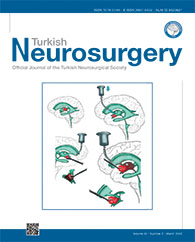2Kingdom Hospital, Riyadh, Saudi Arabia
3Saudi German Hospital, Department of Neurosurgery, Riyadh, Saudi Arabia
4Mansoura University Hospital, Department of Neurosurgery, Mansoura, Egypt
5Prince Mohamed Bin Abdul-Aziz Hospital Riyadh, Saudi Arabia DOI : 10.5137/1019-5149.JTN.33970-21.2 AIM: To evaluate the impact of primary decompressive craniectomy (DC) on the functional outcome in patients with post traumatic acute subdural hematoma (SDH).
MATERIAL and METHODS: A retrospective cohort analysis of 92 patients with post traumatic acute SDH who underwent primary DC and evacuation of SDH. The primary outcome variable is Glasgow outcome scale at 6 months follow up, while exposure variables are demographic data (age and gender), initial Glasgow coma scale, Marshall Classification Score of traumatic brain injury, midline shift, side of the lesion, surgery related complications and time of cranioplasty.
RESULTS: Out of the 92 patients in this study, 89.1% were males and the mean age was 30.2 ± 14.4 years. At admission, the mean Glasgow Coma Scale (GCS) was 5.8 ± 2 and mean Marshall score was 4.7 ± 0.7, while the average midline shift was 8.8 ± 3.5 mm. Right decompressive craniectomy was performed in 46 (50%) patients, while in 2 (2.1%) cases, bi-frontal craniectomy was performed and left decompressive craniectomy was performed in 44 (47.8%) patients. Mortality was reported in 38 patients (41.3%) and poor outcome was reported in 24 patients (26.1%), while 30 patients (32.6%) showed good outcome. During the follow up period, cranioplasty for restoration of the bone defect was completed in 52 patients.
CONCLUSION: Primary decompressive craniectomy after STBI for post-traumatic acute subdural hematoma improved the favorable outcome whenever the initial GCS >4 among adult patients.
Keywords : Acute SDH, Decompressive Craniectomy, Outcome




